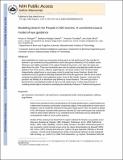| dc.contributor.author | Ehinger, Krista A. | |
| dc.contributor.author | Hidalgo-Sotelo, Barbara Irene | |
| dc.contributor.author | Torralba, Antonio | |
| dc.contributor.author | Oliva, Aude | |
| dc.date.accessioned | 2012-05-25T16:03:43Z | |
| dc.date.available | 2012-05-25T16:03:43Z | |
| dc.date.issued | 2009-08 | |
| dc.identifier.issn | 1350-6285 | |
| dc.identifier.issn | 1464-0716 | |
| dc.identifier.uri | http://hdl.handle.net/1721.1/70942 | |
| dc.description.abstract | How predictable are human eye movements during search in real world scenes? We recorded 14 observers’ eye movements as they performed a search task (person detection) in 912 outdoor scenes. Observers were highly consistent in the regions fixated during search, even when the target was absent from the scene. These eye movements were used to evaluate computational models of search guidance from three sources: Saliency, target features, and scene context. Each of these models independently outperformed a cross-image control in predicting human fixations. Models that combined sources of guidance ultimately predicted 94% of human agreement, with the scene context component providing the most explanatory power. None of the models, however, could reach the precision and fidelity of an attentional map defined by human fixations. This work puts forth a benchmark for computational models of search in real world scenes. Further improvements in modelling should capture mechanisms underlying the selectivity of observers’ fixations during search. | en_US |
| dc.description.sponsorship | National Eye Institute (Integrative Training Program in Vision grant T32 EY013935) | en_US |
| dc.description.sponsorship | Massachusetts Institute of Technology (Singleton Graduate Research Fellowship) | en_US |
| dc.description.sponsorship | National Science Foundation (U.S.) (Graduate Research Fellowship) | en_US |
| dc.description.sponsorship | National Science Foundation (U.S.) (CAREER Award (0546262)) | en_US |
| dc.description.sponsorship | National Science Foundation (U.S.) (NSF contract (0705677)) | en_US |
| dc.description.sponsorship | National Science Foundation (U.S.) (Career Award (0747120)) | en_US |
| dc.language.iso | en_US | |
| dc.publisher | Taylor & Francis Group | en_US |
| dc.relation.isversionof | http://dx.doi.org/10.1080/13506280902834720 | en_US |
| dc.rights | Creative Commons Attribution-Noncommercial-Share Alike 3.0 | en_US |
| dc.rights.uri | http://creativecommons.org/licenses/by-nc-sa/3.0/ | en_US |
| dc.source | PubMed Central | en_US |
| dc.title | Modelling search for people in 900 scenes: A combined source model of eye guidance | en_US |
| dc.type | Article | en_US |
| dc.identifier.citation | Ehinger, Krista A. et al. “Modelling Search for People in 900 Scenes: A Combined Source Model of Eye Guidance.” Visual Cognition 17.6-7 (2009): 945–978. Web. | en_US |
| dc.contributor.department | Massachusetts Institute of Technology. Computer Science and Artificial Intelligence Laboratory | en_US |
| dc.contributor.department | Massachusetts Institute of Technology. Department of Brain and Cognitive Sciences | en_US |
| dc.contributor.department | Massachusetts Institute of Technology. Department of Electrical Engineering and Computer Science | en_US |
| dc.contributor.approver | Oliva, Aude | |
| dc.contributor.mitauthor | Oliva, Aude | |
| dc.contributor.mitauthor | Ehinger, Krista A. | |
| dc.contributor.mitauthor | Hidalgo-Sotelo, Barbara Irene | |
| dc.contributor.mitauthor | Torralba, Antonio | |
| dc.relation.journal | Visual Cognition | en_US |
| dc.eprint.version | Author's final manuscript | en_US |
| dc.type.uri | http://purl.org/eprint/type/JournalArticle | en_US |
| eprint.status | http://purl.org/eprint/status/PeerReviewed | en_US |
| dspace.orderedauthors | Ehinger, Krista A.; Hidalgo-Sotelo, Barbara Irene; Torralba, Antonio; Oliva, Aude | en |
| dc.identifier.orcid | https://orcid.org/0000-0003-4915-0256 | |
| mit.license | OPEN_ACCESS_POLICY | en_US |
| mit.metadata.status | Complete | |
